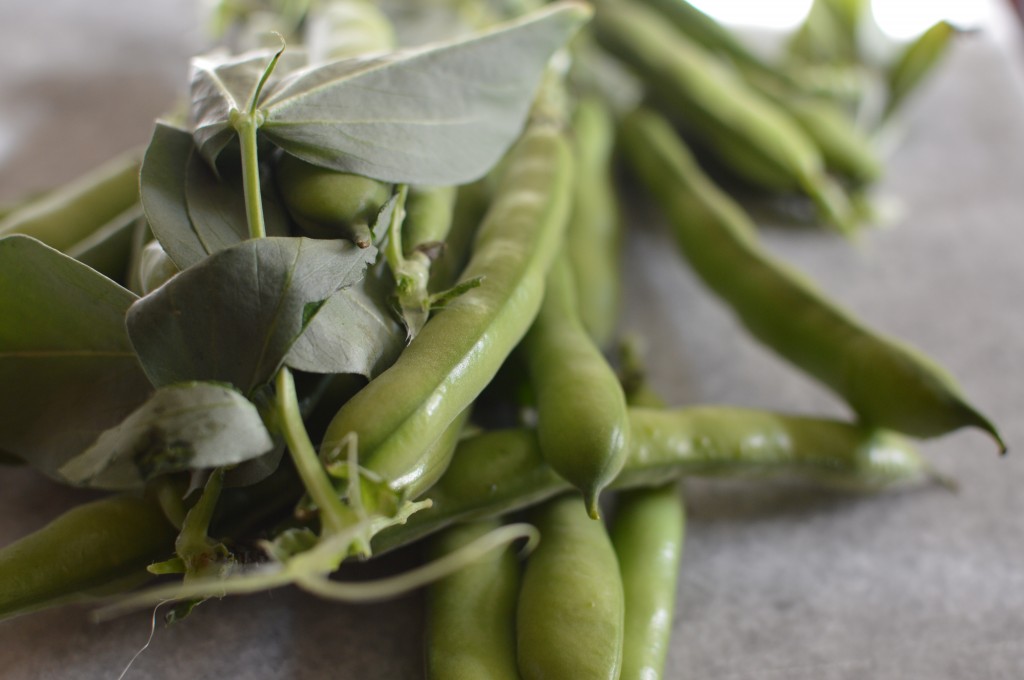 Before we release these favas from their shells, I just wanted to thank you for your comments on my last post. It’s not an easy topic–these thoughts of politics and action! But I appreciate your words so much. It’s a conversation that will stay with me, and I’m thankful to you for that.
Before we release these favas from their shells, I just wanted to thank you for your comments on my last post. It’s not an easy topic–these thoughts of politics and action! But I appreciate your words so much. It’s a conversation that will stay with me, and I’m thankful to you for that.
I have an orchard in my front yard that I planted five or six years ago. It came to be out of the desire to grow food instead of grass on this little acre we live on, and so we put in nine fruit trees, all of which have been struggling along ever since (despite my singing to them, staying up nights worrying about them, etc.–all techniques that seem to work better for children than fruit trees). In the first few years, the deer munched those trees down to little sticks, and so we put a fence around the orchard. It’s a chain link fence, and “temporary” to boot, but to appease both my neighbors (who, I think on the whole, prefer to shortly mown grass to any other plant) and my own aesthetic sensibilities, I try to grow food and flowers around and up the fence, both to cover it and to make use of it as the good growing support that it is. One side of the fence belongs to the favas.
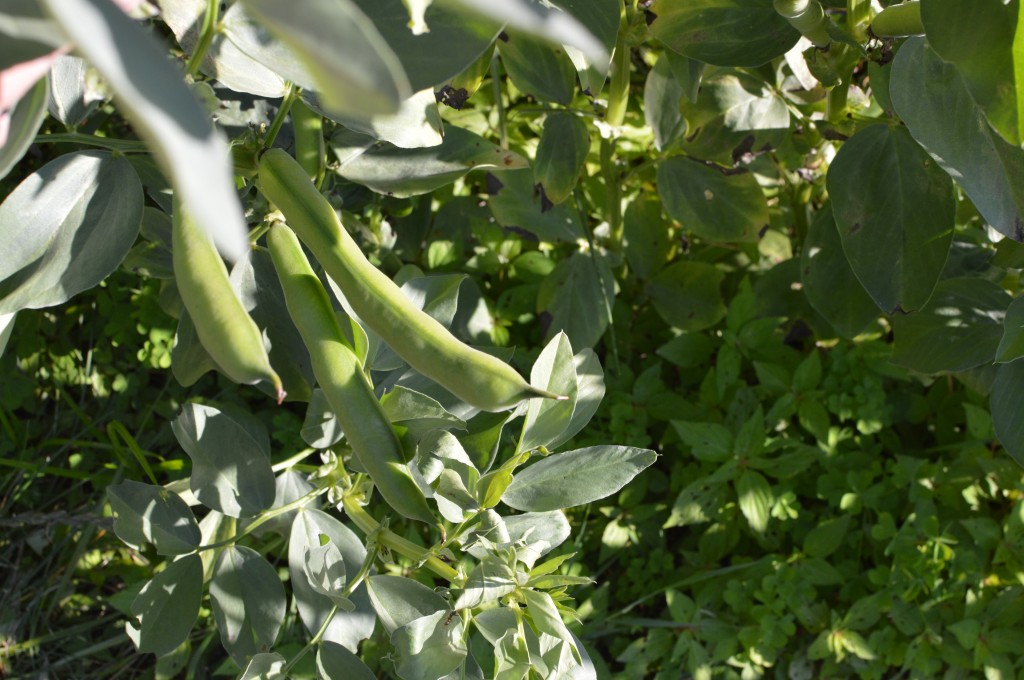 I am getting to that point in the season where I look at other people’s gardens wistfully. Back in late May, when everything was lined up in lovely weedless rows and the paths were mulched with straw, I took friends around for little garden tours (taking all of 10 seconds), and I stuck my chest out like a proud chicken as I showed them the radishes sprouting and the green, green garlic emerging from the ground. Now, there are no paths. Again, like every year, I am growing an excellent crop of thistle if anyone wants some. I just harvested the spindly garlic, and the one pride of the whole thing–twelve voracious and outstandingly alive kale plants of all different varieties have been taken down by our resident ground hog who lives under the porch. I hesitate to say it lest I curse myself, but at least there are tomatoes- big, hard, green tomatoes full of promise, and if all goes well there will be an endless supply through August at least.
I am getting to that point in the season where I look at other people’s gardens wistfully. Back in late May, when everything was lined up in lovely weedless rows and the paths were mulched with straw, I took friends around for little garden tours (taking all of 10 seconds), and I stuck my chest out like a proud chicken as I showed them the radishes sprouting and the green, green garlic emerging from the ground. Now, there are no paths. Again, like every year, I am growing an excellent crop of thistle if anyone wants some. I just harvested the spindly garlic, and the one pride of the whole thing–twelve voracious and outstandingly alive kale plants of all different varieties have been taken down by our resident ground hog who lives under the porch. I hesitate to say it lest I curse myself, but at least there are tomatoes- big, hard, green tomatoes full of promise, and if all goes well there will be an endless supply through August at least.
Still, I love every fruit, vegetable, and leaf. When I ask myself why I do it, that is the answer. I love the things that I get to see grow–the seeds that grow into plants that grow into fruit. Call me crazy, but I love them all.
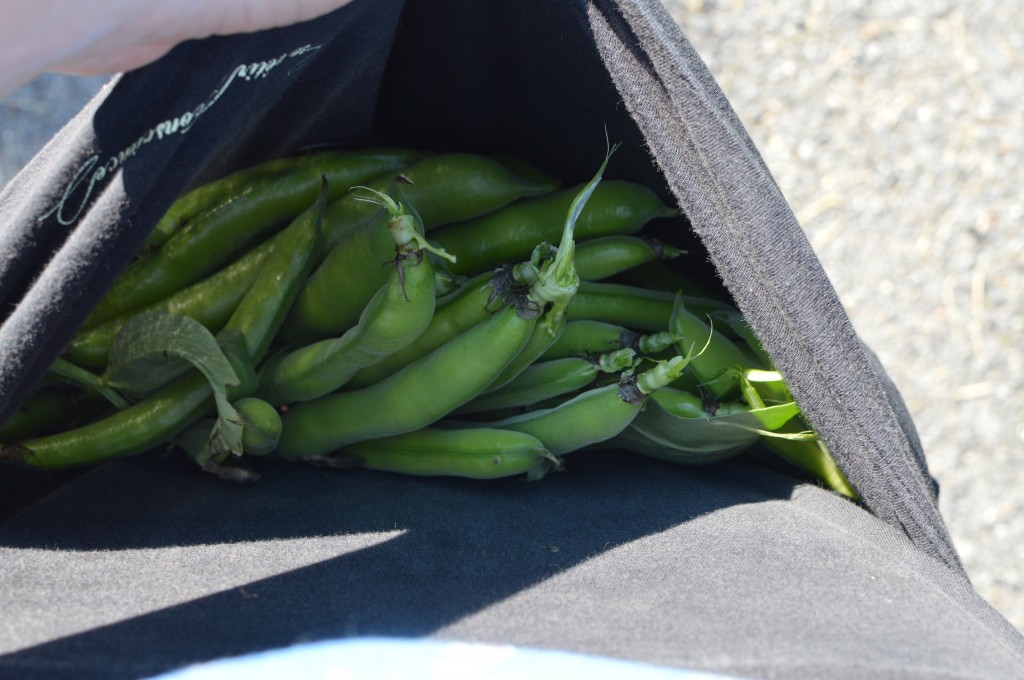 Every year, I grow a line of favas, and they produce enough beans for one meal. Mostly, I grow them because I love to watch the process. First, the long, thick stalk, then the strange black and white flowers that look like insects, and then the pods, leathery outside and furry inside, sticking out at all awkward angles as if they just can’t quite contain themselves. They lack the graceful twirl of the pea plant and the striking teepee of the pole bean. But because they are favas (and someone who knows has taught me to say favas and not fava beans, as the latter is redundant, like cornbread bread), they get away with all of their awkwardness, disturbing beauty, and total lack of efficiency when it comes to how much food they create.
Every year, I grow a line of favas, and they produce enough beans for one meal. Mostly, I grow them because I love to watch the process. First, the long, thick stalk, then the strange black and white flowers that look like insects, and then the pods, leathery outside and furry inside, sticking out at all awkward angles as if they just can’t quite contain themselves. They lack the graceful twirl of the pea plant and the striking teepee of the pole bean. But because they are favas (and someone who knows has taught me to say favas and not fava beans, as the latter is redundant, like cornbread bread), they get away with all of their awkwardness, disturbing beauty, and total lack of efficiency when it comes to how much food they create.
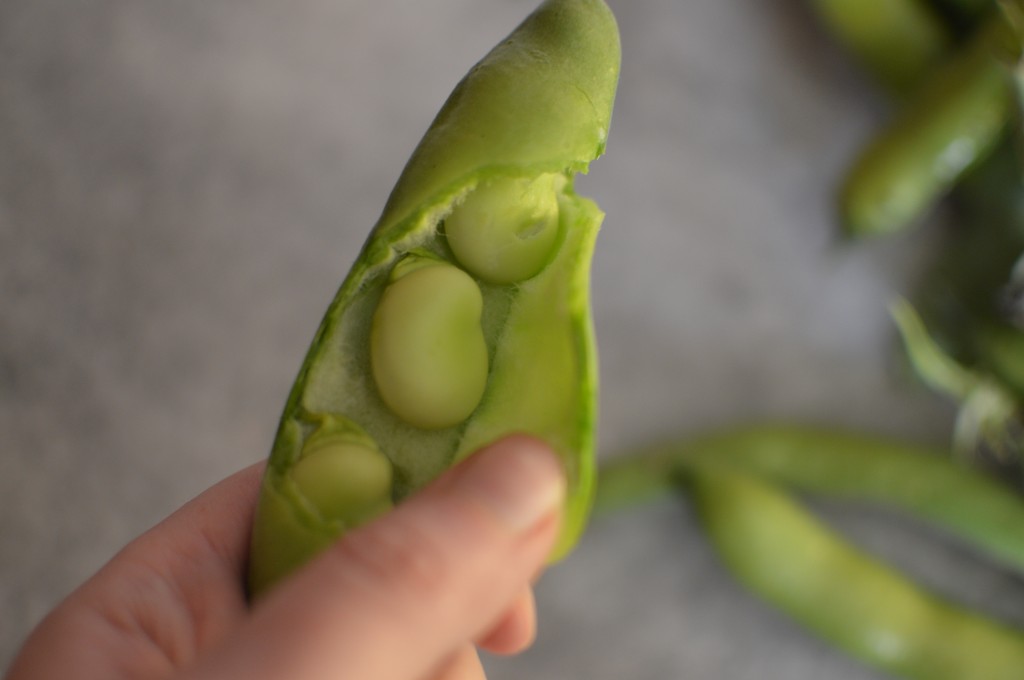 A few months back, I bought a cookbook called Ripe: A Fresh, Colorful Approach to Fruits and Vegetables. I bought it because I had quietly fallen in love with it’s author, who writes a blog called 5 Second Rule. If you don’t read Cheryl Sterman Rule’s site, I’ll make the gentle suggestion that you make room in your heart for one more food blog. Start here if you need convincing.
A few months back, I bought a cookbook called Ripe: A Fresh, Colorful Approach to Fruits and Vegetables. I bought it because I had quietly fallen in love with it’s author, who writes a blog called 5 Second Rule. If you don’t read Cheryl Sterman Rule’s site, I’ll make the gentle suggestion that you make room in your heart for one more food blog. Start here if you need convincing.
Cheryl teamed up with a photographer, Paulette Phlipot, and together they created what I can only describe as a perfect love letter to living food–to juice and crunch and color and everything else that makes fruits and vegetables so exciting to discover, grow, cook and most of all eat. And so I felt that when I finally shared this book with you, it should be in the context of this vegetable that I grow–not for its prolific nature or its usefulness in the kitchen, but because it is strange and outstandingly delicious, and because even though every year I grow exactly enough for 1 meal, I will continue to do so because this vegetable deserves love and celebration. Also, it deserves couscous.
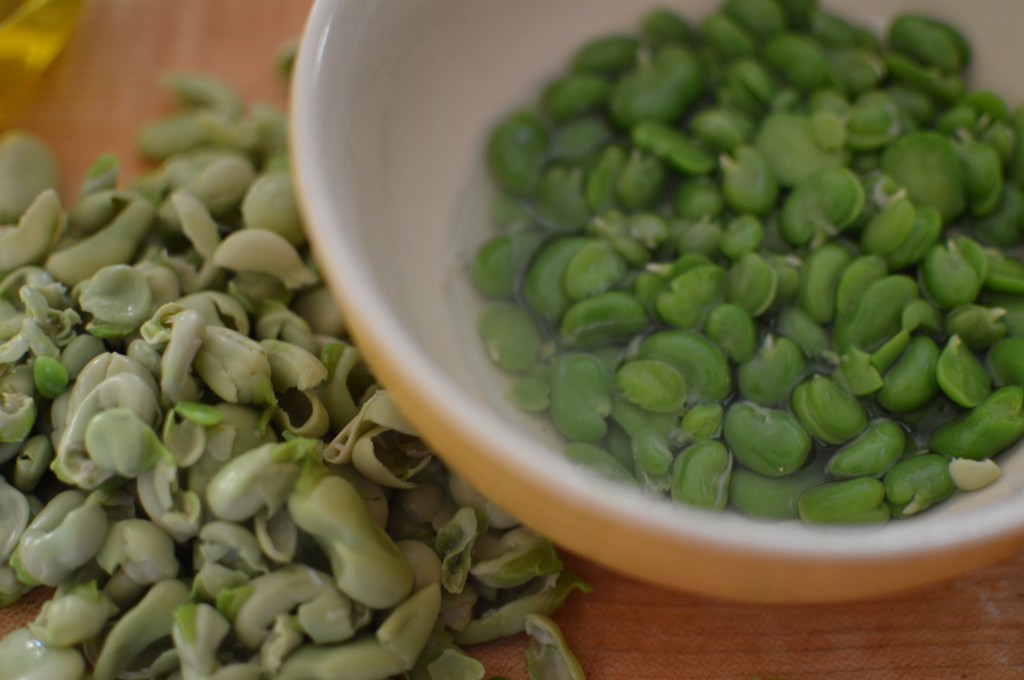 Favas have a bad reputation because they must first be shelled and then they are shelled again, but the inner greenness that you get (especially when it is a fresh grown and gathered in your skirt fava) is worth every step. I made this recipe with the feta and toasted pistachio addition, and I will dream about it until I make it again… next year. I’ve asked Cheryl if I could reprint her recipe exactly here, as I cooked it to the letter and I wouldn’t change a single thing. And yes, you can buy your favas! But some day, if you need a fence that needs covering, I’d throw a few of these seeds in the ground, if only to watch them grow.
Favas have a bad reputation because they must first be shelled and then they are shelled again, but the inner greenness that you get (especially when it is a fresh grown and gathered in your skirt fava) is worth every step. I made this recipe with the feta and toasted pistachio addition, and I will dream about it until I make it again… next year. I’ve asked Cheryl if I could reprint her recipe exactly here, as I cooked it to the letter and I wouldn’t change a single thing. And yes, you can buy your favas! But some day, if you need a fence that needs covering, I’d throw a few of these seeds in the ground, if only to watch them grow.
Warm Fava Shallot Couscous
from Ripe: A Fresh Colorful Approach to Fruits and Vegetables by Cheryl Sterman Rule (with photography by Paulette Phlipot)
From Cheryl: With green favas, pearly couscous, and sweet shallots, this warming sauté is both comforting and light. (To make it more entréelike, toss in some feta and toasted pistachios.) Buy the freshest favas you can find as older beans can be starchy.
Serves 4 as a side
1 1/2 pounds (680g) fresh fava beans (in-pod weight)
1 cup (180g) Israeli (sometimes called pearl) couscous
1/4 cup (60ml) extra-virgin olive oil
1 large shallot or 2 medium shallots, thinly sliced (11/4 cups)
Kosher salt and freshly ground black pepper
1/3 cup (75g) pitted Kalamata olives, sliced
1 lemon, zest removed in long squiggly strips, juice squeezed into a small bowl
2 tablespoons thinly sliced fresh mint leaves
Bring a large pot of water to a boil. Crack the fava pods and squeeze the beans into a bowl. Rinse. Boil the beans for 2 minutes; then remove with a slotted spoon to a colander and rinse again to cool. Transfer to a small bowl. Add the couscous to the same pot and boil until al dente, about 5 minutes, skimming any scum that rises to the surface. Drain; rinse briefly to prevent clumping.
While the couscous cooks, use your thumbnail to pierce each fava’s outer shell. Squeeze the dark green inner beans into a bowl; discard the shells.
In a large skillet, warm the olive oil over medium-high heat until almost shimmering. Add the shallots, 1/4 teaspoon salt, and a grinding of black pepper. Sauté until the shallots are golden brown and starting to crisp, 4 to 5 minutes, stirring frequently to prevent burning. Reduce the heat to very low, add the favas, and stir until warm and glossy, 3 to 5 minutes longer. Test one bean; it should be tender.
Add the couscous to the favas along with the olives and some of the lemon juice, to taste; stir until hot. Adjust the salt and pepper. Garnish with the mint and lemon zest.
Tip: Consider preparing this dish with a friend. It’s nice to have company when you shuck the favas, as this can take a bit of time.
Recipe reprinted with permission from RIPE © 2012 by Cheryl Sternman Rule, Running Press, a member of the Perseus Book Group.
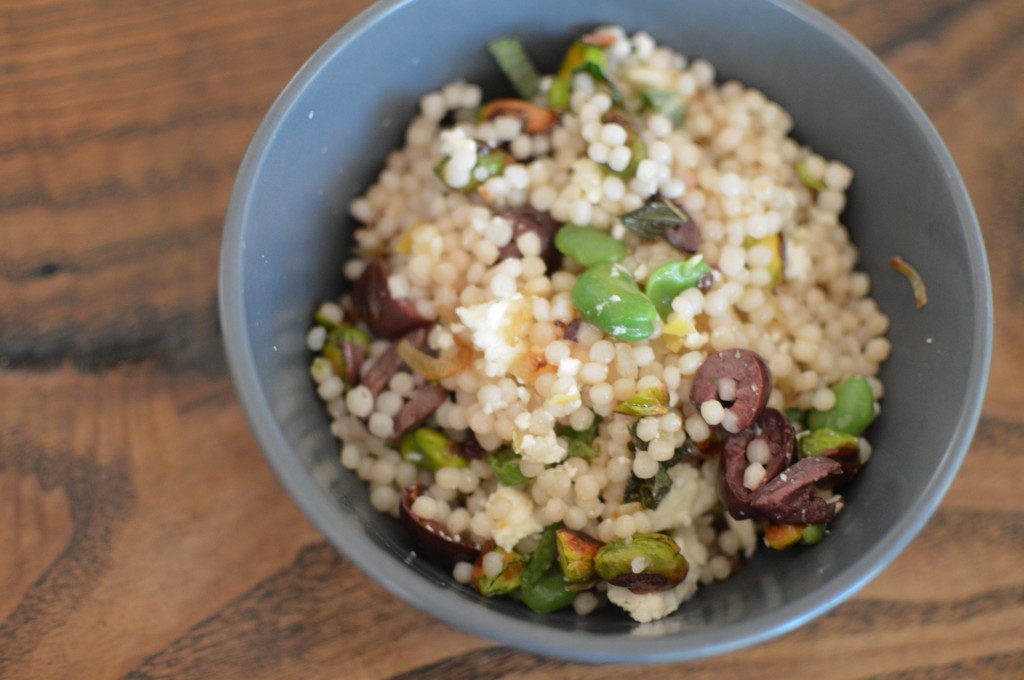

The perfect groundhog abatement trick: fill a 5 ga.llon Bucket with hot water, a big Costco container of red chili pepper flakes and another of garlic powder. Let steep a bit. Throw down the entrance hole. He will leave for good.
I’m going to try it! Here’s hoping I don’t have a ground hog with a taste for spice…
I need no convincing! I too love both 5 Second Rule and Ripe. Favas are a different story, but I will try this recipe next time they appear in my CSA box.
Fava beans are well worth the trouble of shelling–especially for a beautiful couscous like that! I could eat some right now. 🙂
Having fallen equally in adoration with you and your writing, this post is a heady gift.
And, for what it’s worth, favas and I have much in common: we are both awkward, and inefficient, but — I like to think in my quieter moments — ultimately worth the effort. Thank you for making the effort to get to know me through my work.
I cannot wait to share you with my audience.
Oh, so worth it, Cheryl. And every bit of the work is a joy… thanks so much for doing what you do. xo
What a wonderful idea. I usually end up double peeling, blanching and crushing my broad beans (as they are known here) with garlic, olive oil, lemon juice and finely grated pecorino – gorgeous on bruschetta or stirred through hot pasta (with a little of the pasta water).
The last time I grew them I had the opposite problem: we were absolutely overwhelmed, even when we gave away great bagsful. I didn’t plant any last year and have put in a more modest row this year so we’ll truly enjoy what we grow. It’s still winter and we’re waiting for flowers, although my neighbours’ plants are flowering already.
I love favas!!! My family is from the Azores. I grew up growing and eating them all year long. They freeze great.
Try growing them under your fruit trees. My grandfather did this. From what I remember it helped our fruit trees produce better fruit.
Great Blog!!!
I just relocated 2 juvenile groundhogs that mowed my community garden to almost nothing to a new riverside location.
First, your prose makes my mouth water almost as much as a ripe summer tomato. Your words so perfectly express my love affair with my garden. Last night I lay awake, unable to quiet my weary brain – all wrapped up in the posibilities lying wait in my fridge. Do you think it is odd to be kept awake with thoughts of jam and spicy eggplant pickle? I bet you don’t think it is odd at all and that is why I love your blog so. Oh, and my husband adores favas so since we are not growing them this year I may just have to score some somewhere to try this recipe – sounds so yummy!
I have some serious fence-growing envy! Hubs put up a beautiful aluminum fence he scrounged locally and pieced together. He’s so proud of his work that he’s firmly requested that I not grow anything on/against it or that is so tall that it blocks the view of the fence from passersby. Lest he sound like a controlling ogre, he is crazy indulgent with me when it comes to my food growing whims. I suppose space for favas will have to wait a bit…
So summery, so delicious! Make me want to go straight to the kitchen!